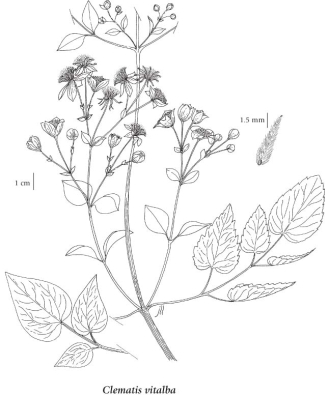Click on the image below to view an
expanded illustration for this species.

|
General:
Perennial woody vine; stems climbing, to 12 m long, grooved, sparsely hairy.
Leaves:
Opposite, long-stalked, pinnately compound, the leaflets 5, stalked, heart-shaped, to 8 cm long, 3-5 cm wide, coarsely toothed to entire, minutely-hairy on veins below, smooth above; the stalks act as tendrils.
Flowers:
Inflorescence of axillary and terminal cymes of 5 to 22 flowers, the flowers bisexual; bracts small; flower stalks slender, 1-1.5 cm long, minutely-hairy; petals absent; sepals 4 (-6), wide-spreading, white to cream, elliptic or egg-shaped to oblanceolate, about 1 cm long, about 0.5 cm wide, densely woolly-hairy on both surfaces; stamens about 50; pistils 20 or more.
Fruits:
Achenes, rounded, densely-hairy; beaks about 3.5 cm long, feathery-hairy.
Source: The Illustrated Flora of British Columbia
|
